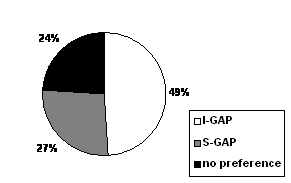McCormick Place, Lakeside Center
Sunday, September 25, 2005
9:00 AM - 5:00 PM
McCormick Place, Lakeside Center
Monday, September 26, 2005
9:00 AM - 5:00 PM
McCormick Place, Lakeside Center
Tuesday, September 27, 2005
9:00 AM - 5:00 PM
McCormick Place, Lakeside Center
Wednesday, September 28, 2005
9:00 AM - 5:00 PM
8231
Microvascular Breast Reconstruction Using Buttock Tissue: the Preferred Scar Location and Shape
INTRODUCTION: When abdominal tissue is not available, the buttock is a potential donor site for microsurgical breast reconstruction. Superior gluteal artery perforator (S-GAP) and inferior (“In the Crease”) gluteal artery perforator (I-GAP) flaps can be performed with equal success. The final buttock scar and shape differ depending on flap harvest donor site. The goal of this study is to determine the preferred postoperative donor buttock scar location and shape. MATERIALS & METHODS: A survey was designed and distributed for research participants to complete. A short slide presentation was given, which included examples of preoperative and postoperative results. Participants were asked to evaluate postoperative donor buttock scars and shape after gluteal artery perforator flap harvest. Reconstructive goals, outcomes, preferred buttock scar location and shape, acceptable operative and recovery time, and preferred donor sites were all evaluated. RESULTS: 162 participants enrolled in this survey. First, they ranked in order the factors important for successful breast reconstruction. The most to least important factors were as followed: final breast shape, final body aesthetic shape, final breast texture “natural feel,” final donor site scar, quick recovery, and short operation. When evaluating gluteal donor scars, 73% of the participants preferred the I-GAP donor site scar location, 11% preferred the S-GAP donor site scar location, and 16% had no preference. When evaluating gluteal donor shape, 49% of the participants preferred the I-GAP donor site buttock shape, 27% preferred the S-GAP donor site shape, and 24% had no preference. When evaluating operative time, 32% of participants would consider this surgical technique if the operative time was 4 hours, 28% if the operative time was 8 hours, 7% if the operative time was 12 hours, while 30% of the participants did not feel the operative time was important. 4% would not consider this breast reconstruction technique regardless of operative time. When evaluating recovery time, 26% of participants would consider this breast reconstruction technique if recovery time was 3 days, 20% if recovery time was 5 days, 10% if recovery time was 7 days, while 37% of the participants did not feel recovery time was important. 7% would not consider this technique regardless of recovery time. If given the choice between abdominal and buttock donor sites for breast reconstruction, 46% of the participants chose the abdomen, while 34% and 20% chose I-GAP and S-GAP donor sites, respectively. Abdominal tissue was preferred because the scar was less visible and the overall body shape was better. CONCLUSIONS: If buttock tissue is used to reconstruct a breast, the majority of survey participants prefer both the postoperative I-GAP buttock scar location and shape. However, the abdomen remains the preferred donor site when all flap donor sites are available. The participants of this survey felt the most important determinants in successful breast reconstruction outcome are final breast shape, final body aesthetic shape, and final breast texture “natural feel,” respectively. Operative and recovery time are less important in patient decision making for breast reconstruction.
Graph 1 (a, b) Gluteal artery perforator flaps for microsurgical breast reconstruction survey results (n=162 participants) (a) The preferred postoperative buttock scar (b) The preferred postoperative buttock shape
View Synopsis (.doc format, 53.0 kb)


